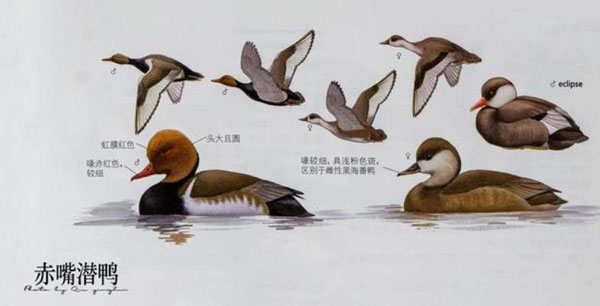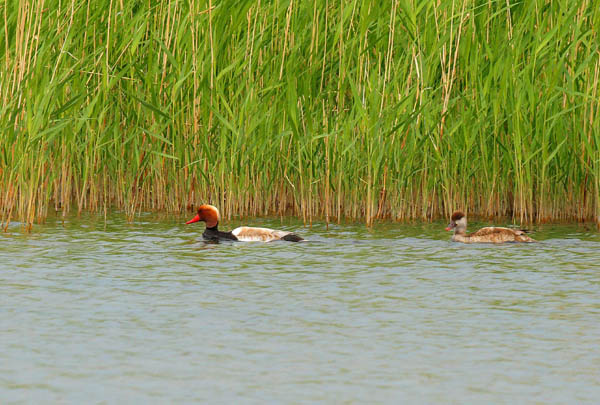Netta rufina
IUCN
LCBasic Information
Scientific classification
- name:Netta rufina
- Scientific Name:Big red head, red-billed pochard,Netta rufina,Red-crested Pochard
- Outline:Waterfowl
- Family:Anseriformes Anatidae Duckling
Vital signs
- length:45-55cm
- Weight:900-1250g
- lifetime:7years
Feature
Large duck that is a heavy, slow flyer.
Distribution and Habitat
In China, it breeds in Xinjiang and Inner Mongolia, and winters in clusters in the plateau lakes in the southwest. There are sporadic records of wintering in central and southern China, and stray birds go to Jiangsu, Zhejiang and Taiwan. Abroad, it mainly breeds in Central Europe, Eastern Europe and Central Asia, and winters in the Mediterranean, Northeast Africa, northern South Asia and northern Myanmar.
It mainly inhabits open freshwater lakes, rivers with slow currents, rivers, estuaries, deltas or saline lakes. It also often appears in bubbles on both sides of the road, especially in freshwater lakes with waterside plants and deeper water; it is occasionally seen in fishing areas where human activities are frequent.
Appearance
The male has a large body. The male has a round and swollen head that is brownish yellow, an orange-yellow top, a gray-brown upper body, white wings, and a black or gray-black lower body from the forechest to the tail, with white flanks. The female is grayish brown all over, with grayish white cheeks, throat and neck. The iris of the male is red, while the female is reddish brown. The beak of the male is bright red, while the female is grayish black, with yellow in the front. The feet of the male are orange-red, while the female is grayish black.
Details
Red-billed Pochards are slow-witted and not very afraid of people. They are not good at calling, and often move in pairs or small groups, sometimes in large groups of hundreds. When resting, they often rest in groups on the sandbanks and islands in the middle of the lake with water plants, and they also mix with other wild ducks. They often dive into the water to feed on algae, fish and shrimp. They build nests in reeds during the breeding season. They fly clumsily and slowly.

They mainly feed by diving, and often forage in shallow water with their tails up and their heads down. They forage mostly in the early morning and evening. During the day, they often swim and play in open water areas, or float motionlessly on the water surface. Their food mainly consists of young shoots, stems and seeds of algae, duckweed and other aquatic plants. Sometimes they also go to the shore to forage for grass and some other seeds or grass seeds of Gramineae plants. In winter, they sometimes go to farmlands to forage for scattered grains.
In spring, they migrate from their wintering grounds in the south to their breeding grounds in the northwest and Inner Mongolia from early to mid-April, and some arrive as late as late April or early May. In autumn, they begin to migrate southward in late September or early October. They often migrate in groups.

The breeding season is from April to June. Usually they form pairs when they arrive at the breeding grounds in mid-April and start nesting. Usually they nest on the island in the middle of the lake with many reeds and cattails, in the grass by the water and the waterless reeds, and sometimes in the dry reed piles by the lake. The nests are dense, and sometimes 6-7 nests can be found in a reed pile, which are usually well hidden. The nests are made of reed leaves and three-cornered grass, and the inside is padded with soft fine grass and feathers. The nest has an inner diameter of 185 (170-195) mm, an outer diameter of 250 (235-280) mm, and a depth of 60 (55-65) mm. Each nest lays 6-12 eggs, usually 7-9 eggs. The eggs are light gray or pale green, and are 56.2 (55.2-60.5) mm × 41.8 (40.5-44) mm in size. The incubation period is 26-28 days, and the female bird is mainly responsible for incubating the eggs. However, when the female bird leaves the nest to feed, the male bird also takes on the task of incubating the eggs, and the chicks can be hatched in early June.

The population of red-billed pochard in China was once quite abundant. From 1956 to 1967, large groups of thousands of pochards were seen many times in Wulansuhai, Inner Mongolia, and groups of 200-300 pochards were seen in Yili, Xinjiang in early May. However, it is difficult to see such a spectacular scene now, and the population has decreased significantly. According to the Asian Midwinter Waterbird Survey organized by the World Waterfowl Research Bureau in 1992, only 2,598 pochards were seen in China. The decrease in population is due to excessive hunting on the one hand and the deterioration and pollution of the habitat on the other.








